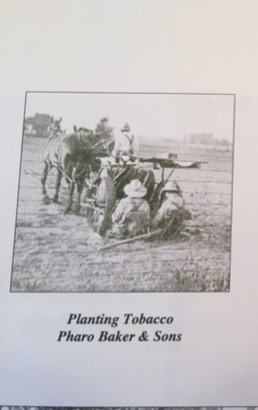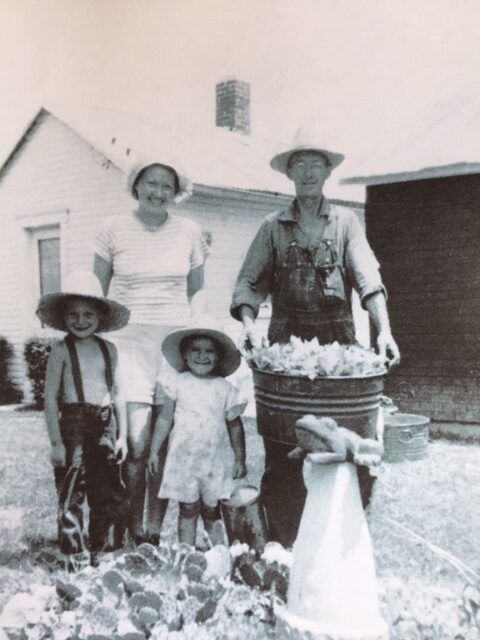
Tobacco was the cash crop in earlier times before soybeans became poplar to plant as a field crop. Most farms planted some acreage of tobacco. It was time consuming and and was very involved for many months of the year. We know there was acres of tobacco as there was lots of tobacco warehouses in Arcanum and community along with tobacco buyers.
This is the story of Dale and Betty (Brumbaugh) Sease and their tobacco farming experience.
History by Dale and Betty Sease. Program given at Arcanum Society 2010.
My parents farmed and raised tobacco from at least the 1940’s mid 1960’s. (It’s possible even during the 1930’s when my mom was a child but we aren’t certain of that.) Comment added by Annette Stewart.
1950 My parents Dale and Betty started farming on their own. Previously they had helped their parents’ farm.

Float during Old Fashioned Days. Note tobacco items and plants on float.
Tobacco:
Used parent’s planter. Started with 6 acres. Three families worked together in harvest time. (Earl Sease, Ruby Sease Gilbert and us, Dale’s siblings).
Made beds which were 50 ft. long to start seed.
Purchased canvas in winter at Smith’s General Store in Arcanum or Pennys in Greenville. Two pieces were sown together. Twine on edges. Use tacks to secure canvas to frame of tobacco bed. Ditmer Brothers came to steam after beds were spaded in April. Set 10ft. pans down on beds to steam to kill weeds. Bought coal from Pitsburg. Steaming cost $24.00 approximately.
Dutch seed sown in beds. Watered and canvas put on to cover. Beds kept moist. Later fertilizer applied. Needed constant attention.

Tobacco plants in tub. Delbert Brumbaugh, Betty, Fred and Shanda Sease.
Plants large enough for planting in May. Canvas off at times to toughen plants. The plants were pulled in morning and put in containers for planting in afternoons. Took a planter with water barrel and driver of tractor and two people to set plants in soil. When planting the planter dispersed water. Ground was prepared in morning for amount of plants that were to be planted. Barrel needed to be kept filled with water. As a child, I remember watching them plant. The planter would cup out a small hole and fill with water. The two people rotated putting the plants in the hole the planter made.
Would plant as plants were large enough and depending on weather until acres were finished. That was usually a few weeks’ time frame. If rained sometimes they needed replanted by hand.
Needed to cultivate soon after planting. Then hoe by hand usually at wheat harvest time (first of July).
Worms came! In later years the acreage was sprayed by plane twice.
The tobacco developed a pink flower. These were broken out by going two rows at a time and breaking off. By fair time (late August) go through and break off suckers in the morning when plant tender.
Cutting began last of August through mid-September so as not to get frosted. Family gathered to cut, spear it putting stalks on a tobacco lathe and hang in sheds to cure. The bundles of lathe were piled high on the wagon and taken to the barns where the men would make an assembly line from wagon to the top of the barn hanging the tobacco on rails to dry.
About Thanksgiving time, pull down laths out of tobacco shed and strip off leaves. The weather needed to be warmer and damp so the leaves were not crushed. It was put on racks to preserve for period of time (not sure what this is?) Leaves sorted, tied, and laid in wooden boxes. Later leaves laid loose in bales and tied in paper. Usually finished late December or January.
Buyers visit and check crops and make offer to buy. They were the Rosenwald Jewish family of National Leaf Company.
Hauled in when crop was done and read for delivery. Tobacco made into cigars.
First crop .20 lb. Last crop .40 lb. Dutch brand paid more but seedleaf was heavier.
When crop done, farmers attended the Farmers Institute at Monroe School for a couple of days. Arcanum, as well as Franklin School, also hosted one.
Next year start all over again!
Transcribed by daughter, Annette Sease Stewart-2020
Annette’s memories:
Written by Dale and Betty’s daughter, Annette Sease Stewart.
I remember the tobacco beds outside the door near the clothesline in the side yard for the transplants. When I was older, Mom would let me take the garden hose with the special sprinkler attachment and help water the beds.
Next, when it was time to plant, Grandma and my mom would sit on the back of the planter and rotate back and forth planting the tobacco plants into the hole the planter would make. Next, during the growing season, the hoeing came for the weeds. I helped do that one week for our neighbor.
And how could I not forget the big green worms! When it was ready to cut, the men cut the stalks in the field. The ladies would take the lathe and special spear and put the tobacco stalk on the wooden lathe and the guys would come back and throw in on the wagon to take to the ventilated barn to hang it in the rafters to dry.
Come winter, there was a fire in the strip shed to warm the building. The dried tobacco was stripped off the lathe and put in the special press boxes. Very dirty!
The best part for us kids was getting together with my cousins at each other’s houses and playing during the harvesting in September.
Later, after soybeans were introduced and my parents’ raised cattle and hogs, we got out of the tobacco farming as we felt it wasn’t a healthy lifestyle product to support.
Please follow AWTHS blog guidelines concerning sharing, copying and use of materials and photos. Information is the property of AWTHS archives.
